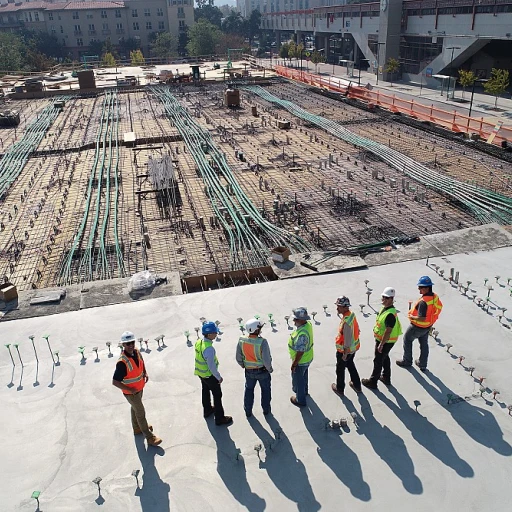
Understanding Ageism: A Workplace Challenge
The Challenge of Ageism in Modern Workplaces
Navigating the evolving landscape of workplace dynamics, ageism has become a pressing issue that requires immediate attention. Age discrimination affects both older and younger employees, contributing to a work environment that might favor one group over another based on age alone. The competitive nature of workplace settings often means that employers might overlook older workers due to preconceived notions about their capabilities. This might include assumptions about technology adaptability or work pace. Similarly, younger employees may be unfairly criticized as lacking experience or maturity, which can be equally damaging. Ageism in employment is not just about unfair hiring practices. It also includes wrongful termination and discriminatory promotion paths. Older adults might face challenges in career advancement, while younger workers could be denied leadership roles based on age-related stereotypes. To combat these issues, it's essential for human resources to recognize and address these biases. Effective intervention can be supported through Human Resources Information Systems (HRIS), which can provide data-driven insights into employment practices. Ultimately, creating a workplace environment that values employees of all ages is crucial. This involves understanding and implementing legal frameworks to protect both older and younger workers from discrimination. The aim should be an inclusive work culture where talent is recognized beyond age-based biases.Identifying Common Examples of Ageism
Common Situations Displaying Age Discrimination
At times, the nuance of ageism can silently permeate the workplace, making it vital to recognize real-world examples that exemplify this issue. Employers, knowingly or unknowingly, may engage in discriminatory practices based on an employee's age. Understanding these scenarios can equip you with the means to combat such trends effectively.
- Job Advertisements: Employers sometimes mention a preference for "young, dynamic candidates" in job postings, which implicitly discourages older workers from applying, despite their experience and qualifications.
- Promotion Practices: Older employees often find themselves overlooked for advancement opportunities. The perception may wrongly suggest they lack the adaptability or energy of younger colleagues. These situations can lead to wrongful termination if older workers are unjustly replaced.
- Training Programs: Initiatives that favor "new and innovative" skills can marginalize employees based on age if they primarily target younger workers, neglecting developmental prospects for older adults.
- Lateral Moves: Older workers may be shifted to less critical roles under the assumption that they are resistant to change or incapable of handling technological advancements, even if they have proven their capabilities in the past.
- Workplace Culture: Age-based jokes or stereotypes create a hostile work environment, which impacts both the morale and the performance of older employees.
Addressing such examples of ageism in the workplace involves a multi-faceted approach. It starts with recognizing these patterns and then implementing strategies that the role of Human Resources can facilitate. These strategies are part of building a diverse, inclusive work environment where people, regardless of age, feel valued and empowered. Leveraging technology, notably Human Resources Information Systems (HRIS), can also play a pivotal role by fostering equitable measures and inclusivity.
The Role of Human Resources in Combating Ageism
The Human Touch in Addressing Age Bias
Human Resources (HR) plays a critical role in identifying and addressing ageism in the workplace. When employees, whether older or younger, face discrimination based on age, HR is on the front lines, working to ensure that companies adhere to employment laws and promote a respectful, inclusive environment. One of the most common examples of age discrimination is the preferential treatment of younger employees over their older counterparts. HR must be vigilant in recognizing such patterns. This requires analyzing data related to hiring, promotions, and terminations to ensure there is no age-based bias in decision-making processes. By leveraging Human Resources Information Systems (HRIS), companies can track detailed employee demographics. This data provides insights that are invaluable in identifying trends indicative of age-based discrimination. For example, if older workers are consistently passed over for promotions in favor of younger employees, HR can investigate further to determine if ageism is at play. HR professionals are also responsible for ensuring that the company’s employment policies align with legal requirements. For instance, many jurisdictions have laws explicitly prohibiting age discrimination, and adherence to these laws is paramount. HR must keep informed of legal frameworks to protect the company from potential lawsuits involving wrongful termination or discrimination based on age. Proactive training programs are another tool HR can use to combat age discrimination. By educating all employees about the negative impacts of ageism, companies can foster a culture that respects the contributions of both younger workers and older adults. Additionally, HR can set the tone for an age-inclusive workplace by crafting job descriptions that appeal to a broad range of ages and by ensuring that benefits packages meet the diverse needs of all employees, regardless of age. In summary, HR is crucial in both identifying and combatting age discrimination in employment. By utilizing HRIS effectively, ensuring compliance with age-related laws, and fostering inclusive workplace practices, HR is more than just a support function; it is a catalyst for creating a genuinely diverse work environment.Leveraging Human Resources Information Systems (HRIS)
Utilizing Technology to Address Ageism
In addressing age discrimination within the workplace, leveraging Human Resources Information Systems (HRIS) can be a game-changer. These systems offer powerful tools to objectively manage and analyze employee data, which can help identify and combat age-based bias.- Data Analysis: HRIS can be used to track and analyze various metrics related to employee demographics, such as ages, roles, and career progression. By examining this data, companies can identify patterns of ageism that might not be immediately visible. For instance, if older employees are consistently passed over for promotions or pay raises compared to their younger counterparts, this could indicate a systemic issue within the organization.
- Objective Management: Human resources can utilize HRIS to implement standardized evaluation criteria across the board. This helps ensure that reviews or promotional opportunities are based on merit rather than age bias. Regular audits of performance reviews can further ensure fairness and transparency, minimizing potential age discrimination.
- Tracking Complaints: Handling complaints of age discrimination in the workplace is another area where HRIS shines. By systematically logging complaints, HR professionals can identify recurring issues or departments that may require more targeted interventions to combat ageism workplace challenges.
- Training and Development: HRIS systems can be leveraged to ensure that training opportunities are distributed equitably among employees, regardless of age. This not only promotes fairness but also enhances the skills of older workers, encouraging them to stay competitive and engaged within their roles.
- Retention Strategies: By analyzing employee turnover rates, HRIS can help determine if older adults are leaving the company at a higher rate. If such trends are evident, employers might want to reconsider their retention strategies and create more age-inclusive policies.
Legal Framework and Policies Against Ageism
Navigating the Complexities of Ageism through Legal Frameworks
The battle against age-based discrimination in the workplace cannot solely rely on company policies and human resource initiatives. Legal frameworks play a crucial role in safeguarding rights and promoting fair employment practices for workers of all ages. Understanding the legal landscape can empower employers, employees, and HR professionals to foster a more age-inclusive environment.
At the core of these protections lies the Age Discrimination in Employment Act (ADEA). This vital legislation prohibits discrimination against individuals aged 40 and over in various aspects of employment. By ensuring that decisions related to hiring, firing, promotions, and job assignments are not based on age, the ADEA aims to create a more equitable workplace for older employees and older adults. However, this protection is exclusive to companies with a certain number of employees, which may leave a gap for some workers.
Other laws and regulations complement the ADEA in addressing ageism. The Equal Employment Opportunity Commission (EEOC) enforces laws ensuring that age should not be a limitation in employment decisions. Additionally, the broader umbrella of employment law includes protections against wrongful termination, further safeguarding older workers from age-based prejudices.
Employers should also be aware of the legal ramifications of age discrimination, as violating these rules could result in significant legal and financial consequences. To mitigate risks, companies can conduct regular training for their staff to recognize and prevent discriminatory practices. It is essential for employers to demonstrate compliance with regulations by creating and updating comprehensive anti-discrimination policies.
Despite these legal safeguards, real-world examples of ageism showcase that enforcement and adherence can sometimes lag. This is where Human Resources can play a pivotal role in ensuring that the principles of non-discrimination translate into everyday practice, as explored in previous sections. Employers can be proactive by regularly reviewing HR processes and employment practices to ensure alignment with these legal standards.
To build a truly inclusive workplace, legal awareness must go hand-in-hand with fostering an environment of respect and equality. By leveraging both HR strategies and legal knowledge, organizations can combat ageism and cultivate a workforce that values diversity among employees of all ages.
Creating an Age-Inclusive Workplace
Fostering an Inclusive Environment for All Ages
Creating an age-inclusive workplace requires deliberate actions and an understanding that ageism, whether towards older or younger employees, can negatively impact the workforce. Employers must actively work towards eliminating age-based discrimination and fostering a culture where workers of all ages can thrive. Here's how companies can make this a reality:
- Promoting Age Diversity: Encourage a mix of younger and older employees in teams to blend the diverse perspectives each generation brings. This not only bolsters creativity but also addresses any stereotypes concerning capability based on age.
- Implementing Equal Opportunities: Ensure that opportunities for advancement, training, and job placements are open to workers of all ages. Age should never be a factor in limiting one's career progression.
- Adapting Work Practices: Acknowledge the different needs of employees age groups. For instance, flexible working arrangements can benefit older workers who may have caregiving responsibilities or health considerations.
- Training and Education: Develop training programs that sensitize all employees on ageism. Highlight real-world examples of discrimination workplace and provide resources to combat age-based biases.
- Reviewing Policies: Regularly review company policies with a lens on employment law provisions on age discrimination. This includes having clear policies against wrongful termination based on age.
- Emphasizing Respectful Communication: Encourage communication that respects all employees ages. Language in the workplace should be inclusive and free from discriminatory undertones about someone's age.
By championing these practices, employers not only comply with legal frameworks discussed earlier but also enhance employee satisfaction and productivity, creating a more harmonious employment environment. The Human Resources department plays a crucial role by leveraging HRIS tools to monitor age diversity and ensure equitable treatment throughout employment practices. Employers who act decisively against ageism set a positive example and help create workplaces that truly value the contributions of every individual, regardless of age.












